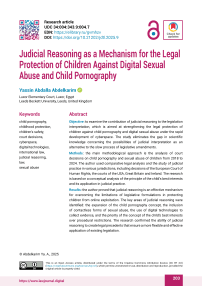Judicial Reasoning as a Mechanism for the Legal Protection of Children Against Digital Sexual Abuse and Child Pornography
Автор: Abdelkarim Ya. A.
Журнал: Journal of Digital Technologies and Law @lawjournal-digital
Статья в выпуске: 3 (2), 2025 года.
Бесплатный доступ
Objective: to examine the contribution of judicial reasoning to the legislation interpretation, which is aimed at strengthening the legal protection of children against child pornography and digital sexual abuse under the rapid development of cyberspace. The study eliminates the gap in scientific knowledge concerning the possibilities of judicial interpretation as an alternative to the slow process of legislative amendments. Methods: the main methodological approach is the analysis of court decisions on child pornography and sexual abuse of children from 2018 to 2024. The author used comparative legal analysis and the study of judicial practice in various jurisdictions, including decisions of the European Court of Human Rights, the courts of the USA, Great Britain and Ireland. The research is based on a conceptual analysis of the principle of the child’s best interests and its application in judicial practice. Results: the author proved that judicial reasoning is an effective mechanism for overcoming the limitations of legislative formulations in protecting children from online exploitation. The key areas of judicial reasoning were identified: the expansion of the child pornography concept, the inclusion of contactless forms of sexual abuse, the use of digital technologies to collect evidence, and the priority of the concept of the child’s best interests over procedural restrictions. The research confirmed the ability of judicial reasoning to create legal precedents that ensure a more flexible and effective application of existing legislation. Scientific novelty: for the first time, the article comprehensively investigated the role of judicial reasoning as a tool for the dynamic interpretation of legal norms of protecting children from digital sexual abuse. The author developed a conceptual model of the interaction between judicial reasoning and the principle of the child’s best interests. The study reveals mechanisms of overcoming legislative stagnation through judicial interpretation of legal norms related to modern forms of child pornography in cyberspace. Practical significance: The study results can be used in judicial practice to substantiate decisions in cases of child pornography, in law-making activities to improve childhood protection standards, and in the practice of law enforcement agencies. The conclusions help to form a more effective justice system that takes into account children’s interests. The research can serve as a basis to develop methodological recommendations on using judicial reasoning in cases of minors’ protection.
Child pornography, childhood protection, children’s safety, court decisions, cyberspace, digital technologies, international law, judicial reasoning, law, sexual abuse
Короткий адрес: https://sciup.org/14132937
IDR: 14132937 | УДК: 34:004:343.9:004.7 | DOI: 10.21202/jdtl.2025.9


